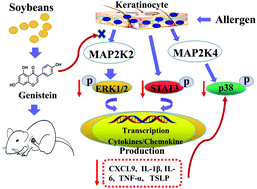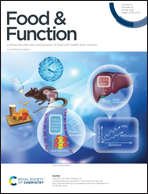Genistein suppresses allergic contact dermatitis through regulating the MAP2K2/ERK pathway†
Abstract
Genistein is one of the main components of soybeans and has been reported to be a potential candidate for the treatment of obesity, cancer, osteoporosis and cardiovascular diseases. Recently, genistein has been shown to have therapeutic effects on some chronic skin diseases, but its underlying mechanisms remain unclear. In this study, we evaluated the role of genistein in alleviating squaric acid dibutylester (SADBE)-induced allergic contact dermatitis (ACD) in mice, and elucidated the potential molecular mechanisms in human keratinocyte (HaCaT) cell line. The impacts of genistein on the production of pro-inflammatory chemokines and cytokines including CXCL9, TSLP, TNF-α, IL-1β and IL-6 in the skin and serum of ACD mice were assessed, as well as the phosphorylation of components in the MAPK and JAK-STAT3 signaling pathways in the skin and dorsal root ganglions (DRGs). The results showed that genistein exerted protective effects on skin damage and inflammatory cell infiltration. Moreover, genistein significantly inhibited the increased expressions of pro-inflammatory factors in skin and peripheral blood, and down-regulated the levels of p-ERK, p-p38 and p-STAT3 in skin and DRGs. Furthermore, genistein inhibited the phosphorylation of ERK and STAT3 to downregulate the expression of cytokines and chemokines, and feedback downregulate phospho-p38 in TNF-α/IFN-γ-induced HaCaT cells. The genistein-mediated inhibitory effect on the MAPK pathway can be reversed by siMAP2K2 but not by siMAP2K4. Altogether, our findings demonstrated that genistein exhibits strong antipruritic and anti-inflammatory effects in ACD mice by inhibiting the production of pro-inflammatory cytokines and intracellular MAP2K2/ERK cell signaling, which makes genistein a potentially valuable candidate for the treatment of skin conditions and systemic syndromes in the setting of contact dermatitis.



 Please wait while we load your content...
Please wait while we load your content...